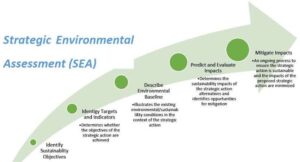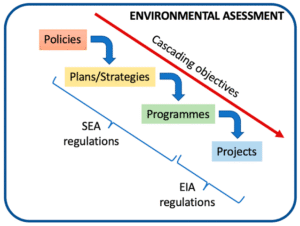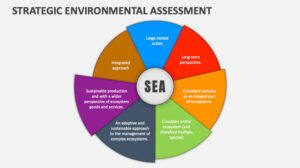Back to: Environmental Biology 500 Level
Welcome to class!
Hello there, my amazing learner! I’m so happy to have you back again. Today’s topic is one that takes environmental thinking to a higher level—before any single project even begins. We’re going to learn about Strategic Environmental Assessment (SEA). This topic shows how governments and big organisations can plan better for the environment right from the start. It’s all about making smart, future-focused decisions that protect both people and nature. Let’s break it down together, in a calm, simple, Nigerian way.
Strategic Environmental Assessment (SEA)
What is Strategic Environmental Assessment (SEA)?
Strategic Environmental Assessment (SEA) is the process of evaluating environmental and social impacts at the policy, plan, or programme level—before individual projects are even proposed.

Unlike EIA, which is done for specific projects like building a dam or a factory, SEA is used for broader decisions—like planning an entire transportation system, an agricultural development policy, or a state-level housing plan.
Example:
If a state government is planning to open up new areas for agriculture, SEA would be used to assess how this decision could affect forests, water sources, rural communities, or wildlife—even before any clearing or construction begins.
Why is SEA Important?
Promotes Sustainable Development Early
SEA puts the environment at the heart of big decisions. This helps avoid future problems before they happen.
Supports Better Policy Planning
Instead of reacting to environmental problems later, SEA helps governments make smarter choices from the beginning.

Protects Ecosystems and Communities
By looking at the big picture, SEA prevents damage to sensitive areas like wetlands, water bodies, and sacred lands.
Complements EIA
SEA sets the foundation, while EIA focuses on individual projects. Both work together to build a cleaner, healthier future.
Key Steps in SEA
Screening – Deciding if the policy, plan, or programme needs an SEA.
Scoping – Identifying which environmental and social issues to focus on.
Baseline Information – Gathering existing data on environmental and social conditions.
Assessment – Predicting the likely impacts of the policy or plan.
Alternatives – Comparing different ways the policy could be implemented.
Public Participation – Getting input from stakeholders and the general public.
Reporting – Preparing an SEA Report for decision-makers.
Monitoring – Checking to see if the predictions and plans are working after implementation.

Nigerian Example:
When the Lagos State Government was preparing its Transport Master Plan, SEA was applied to understand how different options—like railways, BRT buses, or roads—would impact air quality, noise, traffic, and local communities. This helped them choose a more sustainable and people-friendly transport strategy.
Summary
- Strategic Environmental Assessment (SEA) evaluates environmental and social effects of policies, plans, and programmes, not just individual projects.
- SEA happens at an early stage of decision-making.
- It helps protect the environment, improve policies, and avoid future risks.
- SEA complements EIA and leads to more responsible and informed development.
Evaluation
- What is the full meaning of SEA?
- How is SEA different from EIA?
- List three reasons why SEA is important in national planning.
- Mention one example of a policy or plan in Nigeria that could benefit from SEA.
You’ve done so well today! Understanding SEA means you’re now thinking like a true environmental planner—someone who sees the bigger picture and thinks ahead. That’s exactly the kind of leadership Nigeria and Africa need. Keep learning, keep shining, and remember—Afrilearn is proud to be part of your journey. See you in the next class, future policymaker!
